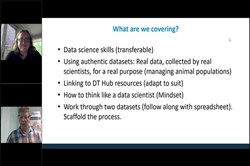Web Literacy Basics
This module cover three areas of web literacy including reading for the web, writing for the web and participating on the web. In reading for the web they assess the credibility of a web resource and learn how the web works. In writing for the web they explore remixing and learn about composing for the web. In participating on the web they explore open content and create an online community task to inspire action.
Additional details
| Year band(s) | 5-6, 7-8 |
|---|---|
| Format | Web page |
| Australian Curriculum Digital Technologies code(s) |
AC9TDI6K01
Investigate the main internal components of common digital systems and their function
AC9TDI6K02
Examine how digital systems form networks to transmit data
AC9TDI6P07
Select and use appropriate digital tools effectively to create, locate and communicate content, applying common conventions
AC9TDI6P08
Select and use appropriate digital tools effectively to share content online, plan tasks and collaborate on projects, demonstrating agreed behaviours
AC9TDI8K01
Explain how hardware specifications affect performance and select appropriate hardware for particular tasks and workloads
AC9TDI8K02
Investigate how data is transmitted and secured in wired and wireless networks including the internet
AC9TDI8P01
Acquire, store and validate data from a range of sources using software, including spreadsheets and databases
AC9TDI8P11
Select and use a range of digital tools efficiently, including unfamiliar features, to create, locate and communicate content, consistently applying common conventions
AC9TDI8P12
Select and use a range of digital tools efficiently and responsibly to share content online, and plan and manage individual and collaborative agile projects |
| Keywords | Digital citizenship, Web Literacy, Open resources, Remixing, Cooperation, Internet, Unplugged, Composing, Interface |
| Integrated, cross-curriculum, special needs | English, Digital Literacy |
| Organisation | Mozilla |
| Copyright | Mozilla Foundation. Creative Commons BY-SA 4.0 |
Related resources
-

Developing Data Science skills (April 2019)
This webinar will be about ways to encourage our students to become data scientists and develop their data science skills.
-

SciGirls
SciGirls videos promote girls in science, technology, engineering and mathematics (STEM).
-

Teaching Robotics with Anjali Rao
Anjali Rao describes how to teach robotics in the classroom.
-

What are binary numbers? - James May's Q&A (Ep 11100) - Head Squeeze
Binary Numbers are explained in this video by Top Gear's James May.
-

ENGLISH Computer Science Unplugged - Part 1 Binary - 2005
This video explains the concept of binary and how it can be used to count.
